Submitted:
08 December 2023
Posted:
12 December 2023
You are already at the latest version
Abstract
Keywords:
1. Introduction
2. Methodology
2.1. Analysis of an Inclined Negatively Buoyant Jet
2.2. The GMDH Method
2.2.1. GMDH Modeling Setup
3. Results and Discussion
3.1. Assessment of the model performance statistically
3.2. Comparing GMDH results with previous models
3.3. Uncertainty analysis
4. Conclusions
Author Contributions
Funding
Institutional Review Board Statement
Informed Consent Statement
Data Availability Statement
Acknowledgments
Conflicts of Interest
References
- Petersen, L. K.; Heck, N.; Reguero, G. B.; Potts, D.; Hovagimian, A.; Paytan, A. Biological and Physical Effects of Brine Discharge from the Carlsbad Desalination Plant and Implications for Future Desalination Plant Constructions. Water 2019, 11 (2). [CrossRef]
- Bombar, G.; Dölgen, D.; Alpaslan, M. N. Environmental impacts and impact mitigation plans for desalination facilities. Desalination and Water Treatment 2016, 57 (25), 11528-11539. [CrossRef]
- Cipollina, A.; Brucato, A.; Grisafi, F.; Nicosia, S. Bench-Scale Investigation of Inclined Dense Jets. Journal of Hydraulic Engineering 2005, 131 (11), 1017-1022. [CrossRef]
- Kikkert, G. A. Buoyant jets with two and three-dimensional trajectories. Doctor of Philosophy, University of Canterbury, Christchurch, New Zealand, 2006. https://ir.canterbury.ac.nz/items/30cdc6c9-3174-479c-9470-30a248cb11c4.
- Zeitoun, M. A.; McIlhenny, W. F. 1971. Conceptual Designs of Outfall Systems for Desalination Plants. In Proceedings of the Offshore Technology Conference, Houston, Texas. 2006. OTC-1370-MS. [CrossRef]
- Abessi, O.; Roberts, P. J. W. Dense Jet Discharges in Shallow Water. Journal of Hydraulic Engineering 2015, 142 (1), 04015033. [CrossRef]
- Papakonstantis, I. G.; Christodoulou, G. C. Discussion of “Inclined Negatively Buoyant Discharges” by G. A. Kikkert, M. J. Davidson, and R. I. Nokes. Journal of Hydraulic Engineering 2008, 134 (12), 1782-1784. [CrossRef]
- Abessi, O.; Roberts, P. J. W. Effect of Nozzle Orientation on Dense Jets in Stagnant Environments. Journal of Hydraulic Engineering 2015, 141 (8), 06015009. [CrossRef]
- Bashitialshaaer, R.; Larson, M.; Persson, K. M. An Experimental Investigation on Inclined Negatively Buoyant Jets. Water 2012, 4 (3), 720-738. [CrossRef]
- Nemlioglu, S.; Roberts, P. J. W. 2006. Experiments on dense jets using three-dimensional laser-induced fluorescence (3DLIF). In MWWD 2006 -The 4th international conference on marine waste water disposal and marine environment, Antalya, Turkey, November 6-10/2006.
- Lindberg, W. R. Experiments on Negatively Buoyant Jets, with and without Cross-Flow. In Recent Research Advances in the Fluid Mechanics of Turbulent Jets and Plumes, Davies, P. A., Neves, M. J. V. Eds.; Springer Netherlands, 1994; pp 131-145.
- Roberts Philip, J. W.; Toms, G. Inclined Dense Jets in Flowing Current. Journal of Hydraulic Engineering 1987, 113 (3), 323-340. (acccessed 2023/11/27). [CrossRef]
- Papakonstantis, I. G.; Christodoulou, G. C.; Papanicolaou, P. N. Inclined negatively buoyant jets 1: geometrical characteristics. Journal of Hydraulic Research 2011, 49 (1), 3-12. [CrossRef]
- Papakonstantis, I. G.; Christodoulou, G. C.; Papanicolaou, P. N. Inclined negatively buoyant jets 2: concentration measurements. Journal of Hydraulic Research 2011, 49 (1), 13-22. [CrossRef]
- Crowe, A. Inclined negatively buoyant jets and boundary interaction. Doctor of Philosophy, University of Canterbury, Christchurch, New Zealand, 2013. http://hdl.handle.net/10092/7895.
- Bloomfield, L. J.; Kerr, R. C. Inclined turbulent fountains. Journal of fluid mechanics 2002, 451, 283-294. [CrossRef]
- Shao, D.; Law, A. W.-K. Mixing and boundary interactions of 30° and 45° inclined dense jets. Environmental Fluid Mechanics 2010, 10 (5), 521-553. [CrossRef]
- Papakonstantis, I. G.; Tsatsara, E. I. Mixing Characteristics of Inclined Turbulent Dense Jets. Environmental Processes 2019, 6 (2), 525-541. [CrossRef]
- Roberts, P. J. W.; Ferrier, A.; Daviero, G. Mixing in Inclined Dense Jets. Journal of Hydraulic Engineering 1997, 123 (8), 693-699. [CrossRef]
- Jiang, B.; Law, A. W.-K.; Lee, J. H.-W. Mixing of 30° and 45° Inclined Dense Jets in Shallow Coastal Waters. Journal of Hydraulic Engineering 2014, 140 (3), 241-253. [CrossRef]
- Chung Kei Chris, L. Mixing of inclined dense jets. Master thesis, the University of Hong Kong, Pokfulam, Hong Kong, 2009. http://hdl.handle.net/10722/65319.
- Lai, C. C. K.; Lee, J. H. W. Mixing of inclined dense jets in stationary ambient. Journal of Hydro-environment Research 2012, 6 (1), 9-28. [CrossRef]
- Abessi, O.; Roberts, P. J. W. Multiport Diffusers for Dense Discharges. Journal of Hydraulic Engineering 2014, 140 (8), 04014032. [CrossRef]
- Oliver, C. Near field mixing of negatively buoyant jets. Doctor of Philosophy, University of Canterbury, Christchurch, New Zealand, 2012. http://hdl.handle.net/10092/6300.
- Papakonstantis, I. G.; Tsatsara, E. I. Trajectory Characteristics of Inclined Turbulent Dense Jets. Environmental Processes 2018, 5 (3), 539-554. [CrossRef]
- Papanicolaou, P. N.; Kokkalis, T. J. Vertical buoyancy preserving and non-preserving fountains, in a homogeneous calm ambient. International Journal of Heat and Mass Transfer 2008, 51 (15), 4109-4120. [CrossRef]
- Lee, J. H. W.; Chu, V. H. Turbulent jets and plumes: a Lagrangian approach; Springer: New York, NY, USA, 2003. [CrossRef]
- Jirka, G. H. Integral Model for Turbulent Buoyant Jets in Unbounded Stratified Flows. Part I: Single Round Jet. Environmental Fluid Mechanics 2004, 4 (1), 1-56. [CrossRef]
- Kikkert, G. A.; Davidson, M. J.; Nokes, R. I. Inclined Negatively Buoyant Discharges. Journal of Hydraulic Engineering 2007, 133 (5), 545-554. [CrossRef]
- Oliver, C. J.; Davidson, M. J.; Nokes, R. I. Predicting the near-field mixing of desalination discharges in a stationary environment. Desalination 2013, 309, 148-155. [CrossRef]
- Zaji, A. H.; Bonakdari, H. Robustness lake water level prediction using the search heuristic-based artificial intelligence methods. ISH Journal of Hydraulic Engineering 2019, 25 (3), 316-324. [CrossRef]
- Alitaleshi, F.; Daghbandan, A. Using a multi-objective optimal design of GMDH type neural networks to evaluate the quality of treated water in a water treatment plant. Desalination and Water Treatment 2019, 139, 123-132. [CrossRef]
- Naeini, S. A.; Moayed, R. Z.; Kordnaeij, A.; Mola-Abasi, H. Elasticity modulus of clayey deposits estimation using group method of data handling type neural network. Measurement 2018, 121, 335-343. [CrossRef]
- Parsaie, A.; Haghiabi, A. H. Improving Modelling of Discharge Coefficient of Triangular Labyrinth Lateral Weirs Using SVM, GMDH and MARS Techniques. Irrigation and Drainage 2017, 66 (4), 636-654. (acccessed 2023/11/27). [CrossRef]
- Gholami, A.; Bonakdari, H.; Ebtehaj, I.; Shaghaghi, S.; Khoshbin, F. Developing an expert group method of data handling system for predicting the geometry of a stable channel with a gravel bed. Earth Surface Processes and Landforms 2017, 42 (10), 1460-1471. (acccessed 2023/11/27). [CrossRef]
- Najafzadeh, M.; Zahiri, A. Neuro-Fuzzy GMDH-Based Evolutionary Algorithms to Predict Flow Discharge in Straight Compound Channels. Journal of Hydrologic Engineering 2015, 20 (12), 04015035. [CrossRef]
- Najafzadeh, M.; Barani, G.-A.; Hessami-Kermani, M.-R. Evaluation of GMDH networks for prediction of local scour depth at bridge abutments in coarse sediments with thinly armored beds. Ocean Engineering 2015, 104, 387-396. [CrossRef]
- Ebtehaj, I.; Bonakdari, H.; Zaji, A. H.; Azimi, H.; Khoshbin, F. GMDH-type neural network approach for modeling the discharge coefficient of rectangular sharp-crested side weirs. Engineering Science and Technology, an International Journal 2015, 18 (4), 746-757. [CrossRef]
- Najafzadeh, M.; Barani, G. A.; Hessami-Kermani, M. R. Group method of data handling to predict scour depth around vertical piles under regular waves. Scientia Iranica 2013, 20 (3), 406-413. [CrossRef]
- Madandoust, R.; Bungey, J. H.; Ghavidel, R. Prediction of the concrete compressive strength by means of core testing using GMDH-type neural network and ANFIS models. Computational Materials Science 2012, 51 (1), 261-272. [CrossRef]
- Alfaifi, H.; Abdolmajid, M.; Bonakdari, H. Experimental Investigation and Model Development of Geometric Characteristics of Negatively Buoyant Jets Inclined at 15° and 52° using GMDH Method. Journal of Coastal Research 2020, 36 (3), 636-653. [CrossRef]
- Rostami, A.; Hemmati-Sarapardeh, A.; Karkevandi-Talkhooncheh, A.; Husein, M. M.; Shamshirband, S.; Rabczuk, T. Modeling heat capacity of ionic liquids using group method of data handling: A hybrid and structure-based approach. International Journal of Heat and Mass Transfer 2019, 129, 7-17. [CrossRef]
- Azimi, H.; Bonakdari, H.; Ebtehaj, I. A Highly Efficient Gene Expression Programming Model for Predicting the Discharge Coefficient in a Side Weir along a Trapezoidal Canal. Irrigation and Drainage 2017, 66 (4), 655-666. (acccessed 2023/11/28). [CrossRef]
- Bonakdari, H.; Mohammadian, A. Evolutionary prediction of an inclined dense jet in shallow water. Desalination and Water Treatment 2019, 155, 32-47. [CrossRef]
- Yan, X.; Mohammadian, A.; Ao, R.; Liu, J.; Yang, N. Two-dimensional convolutional neural network outperforms other machine learning architectures for water depth surrogate modeling. Journal of Hydrology 2023, 616, 128812. [CrossRef]
- Yang, J.; Singh, H.; Hines, E. L.; Schlaghecken, F.; Iliescu, D. D.; Leeson, M. S.; Stocks, N. G. Channel selection and classification of electroencephalogram signals: An artificial neural network and genetic algorithm-based approach. Artificial Intelligence in Medicine 2012, 55 (2), 117-126. [CrossRef]
- Morshed, J.; Kaluarachchi, J. J. Application of artificial neural network and genetic algorithm in flow and transport simulations. Advances in Water Resources 1998, 22 (2), 145-158. [CrossRef]
- Chatterjee, S.; Mahapatra, S. S.; Lamberti, L.; Pruncu, C. I. Prediction of welding responses using AI approach: adaptive neuro-fuzzy inference system and genetic programming. Journal of the Brazilian Society of Mechanical Sciences and Engineering 2022, 44 (2), 53. [CrossRef]
- Zhang, W.; Rennie, C. D.; Nistor, I. A new model developed by multigene genetic programming for the temporal evolution of bridge pier scour. Canadian Journal of Civil Engineering 2023, 50 (7), 549-559. [CrossRef]
- Yan, X.; Mohammadian, A. Prediction of a rosette dense jet group in crossflow ambient conditions using multi-gene genetic programming. Desalination and Water Treatment 2020, 190, 440-448. [CrossRef]
- Bahreini Toussi, I.; Mohammadian, A.; Kianoush, R. Prediction of Maximum Pressure at the Roofs of Rectangular Water Tanks Subjected to Harmonic Base Excitation Using the Multi-Gene Genetic Programming Method. Mathematical and Computational Applications 2021, 26 (1), 6. [CrossRef]
- Yan, X.; Wang, Y.; Mohammadian, A.; Liu, J. Simulations of the Concentration Fields of Rosette-Type Multiport Buoyant Discharges Using Combined CFD and Multigene Genetic Programming Techniques. Journal of Marine Science and Engineering 2021, 9 (11), 1311. [CrossRef]
- Yan, X.; Mohammadian, A.; Khelifa, A. Modeling spatial distribution of flow depth in fluvial systems using a hybrid two-dimensional hydraulic-multigene genetic programming approach. Journal of Hydrology 2021, 600, 126517. [CrossRef]
- Yan, X.; Mohammadian, A. Multigene Genetic-Programming-Based Models for Initial Dilution of Laterally Confined Vertical Buoyant Jets. In Journal of Marine Science and Engineering, 2019; Vol. 7.
- Ebtehaj, I.; Bonakdari, H.; Khoshbin, F.; Bong, C. H. J.; Ghani, A. A. Development of group method of data handling based on genetic algorithm to predict incipient motion in rigid rectangular storm water channel. Scientia Iranica 2017, 24 (3), 1000-1009. [CrossRef]
- Najafzadeh, M.; Saberi-Movahed, F. GMDH-GEP to predict free span expansion rates below pipelines under waves. Marine Georesources & Geotechnology 2019, 37 (3), 375-392. [CrossRef]
- Daghbandan, A.; Khalatbari, S.; Abbasi, M. M. Applying GMDH-type neural network for modeling and prediction of turbidity and free residual aluminium in drinking water. Desalination and Water Treatment 2019, 140, 118-131. [CrossRef]
- Ivakhnenko, A. G. Polynomial Theory of Complex Systems. IEEE Transactions on Systems, Man, and Cybernetics 1971, SMC-1 (4), 364-378. [CrossRef]
- GMDH Inc. 2019. GMDH Shell DS (version 3.8.9). GMDH Inc. https://gmdhsoftware.com/.
- Jirka, G. H. Improved Discharge Configurations for Brine Effluents from Desalination Plants. Journal of Hydraulic Engineering 2008, 134 (1), 116-120. [CrossRef]
- Oliver, C. J.; Davidson, M. J.; Nokes, R. I. Removing the boundary influence on negatively buoyant jets. Environmental Fluid Mechanics 2013, 13 (6), 625-648. [CrossRef]
- Shaghaghi, S.; Bonakdari, H.; Gholami, A.; Ebtehaj, I.; Zeinolabedini, M. Comparative analysis of GMDH neural network based on genetic algorithm and particle swarm optimization in stable channel design. Applied Mathematics and Computation 2017, 313, 271-286. [CrossRef]
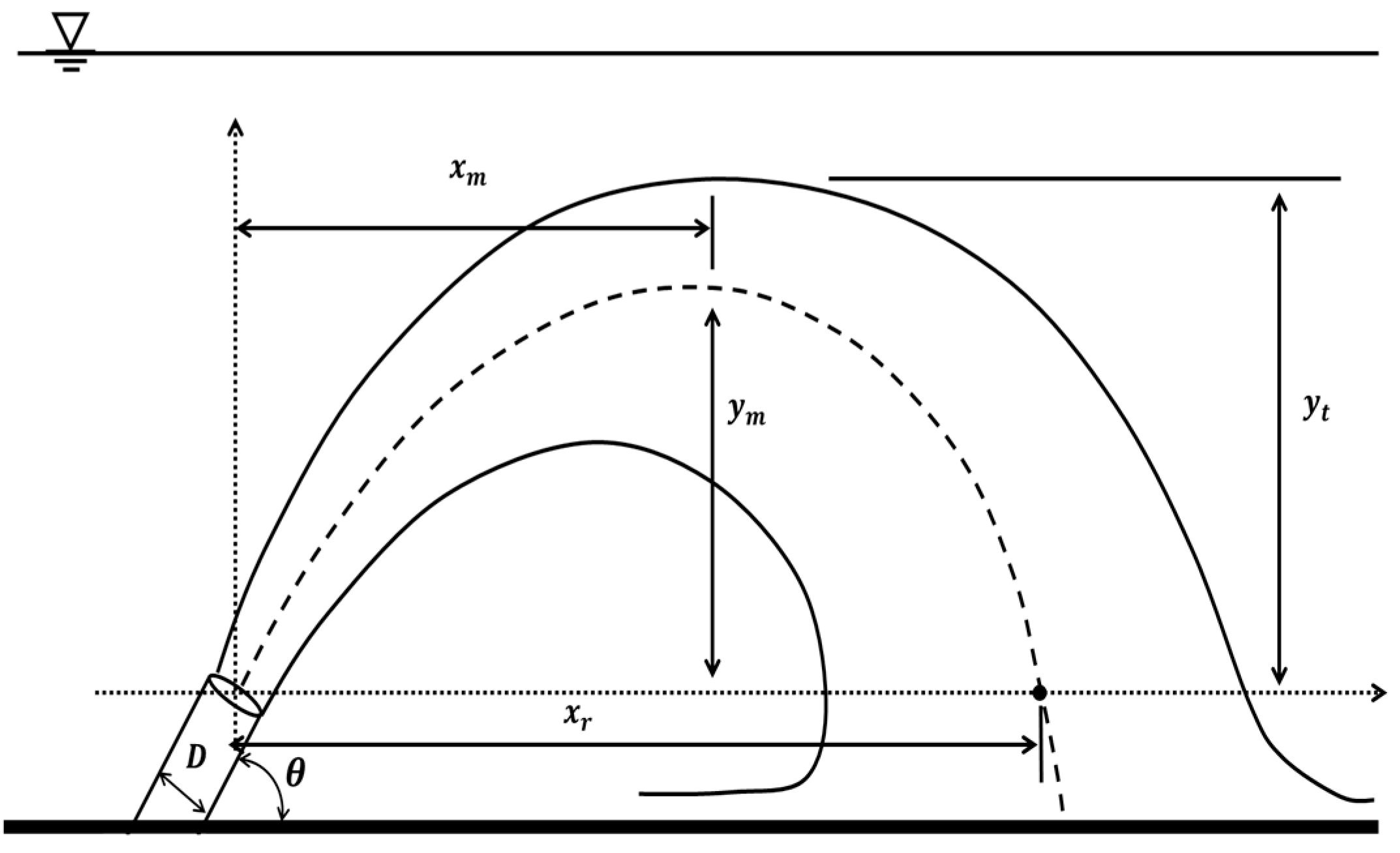
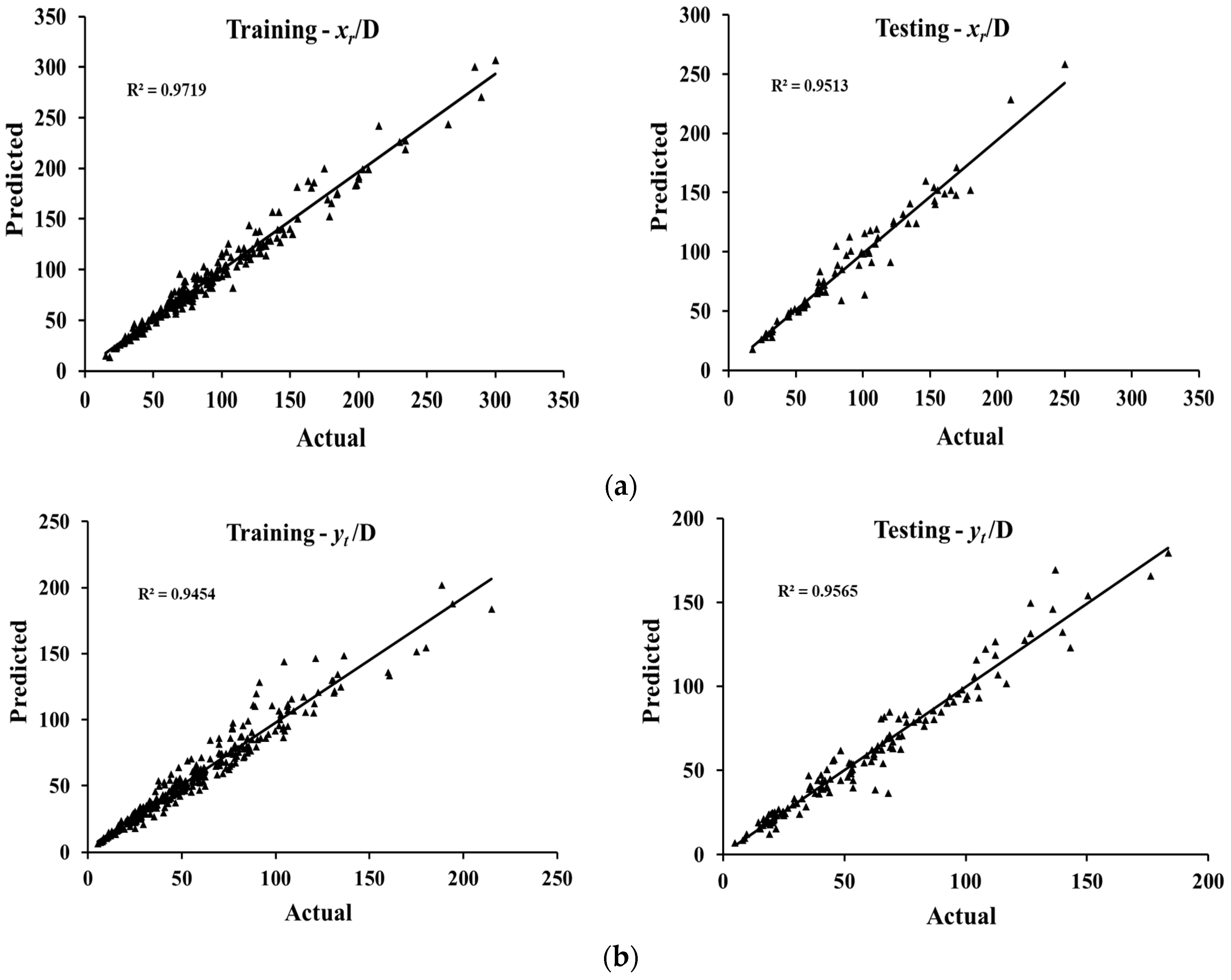
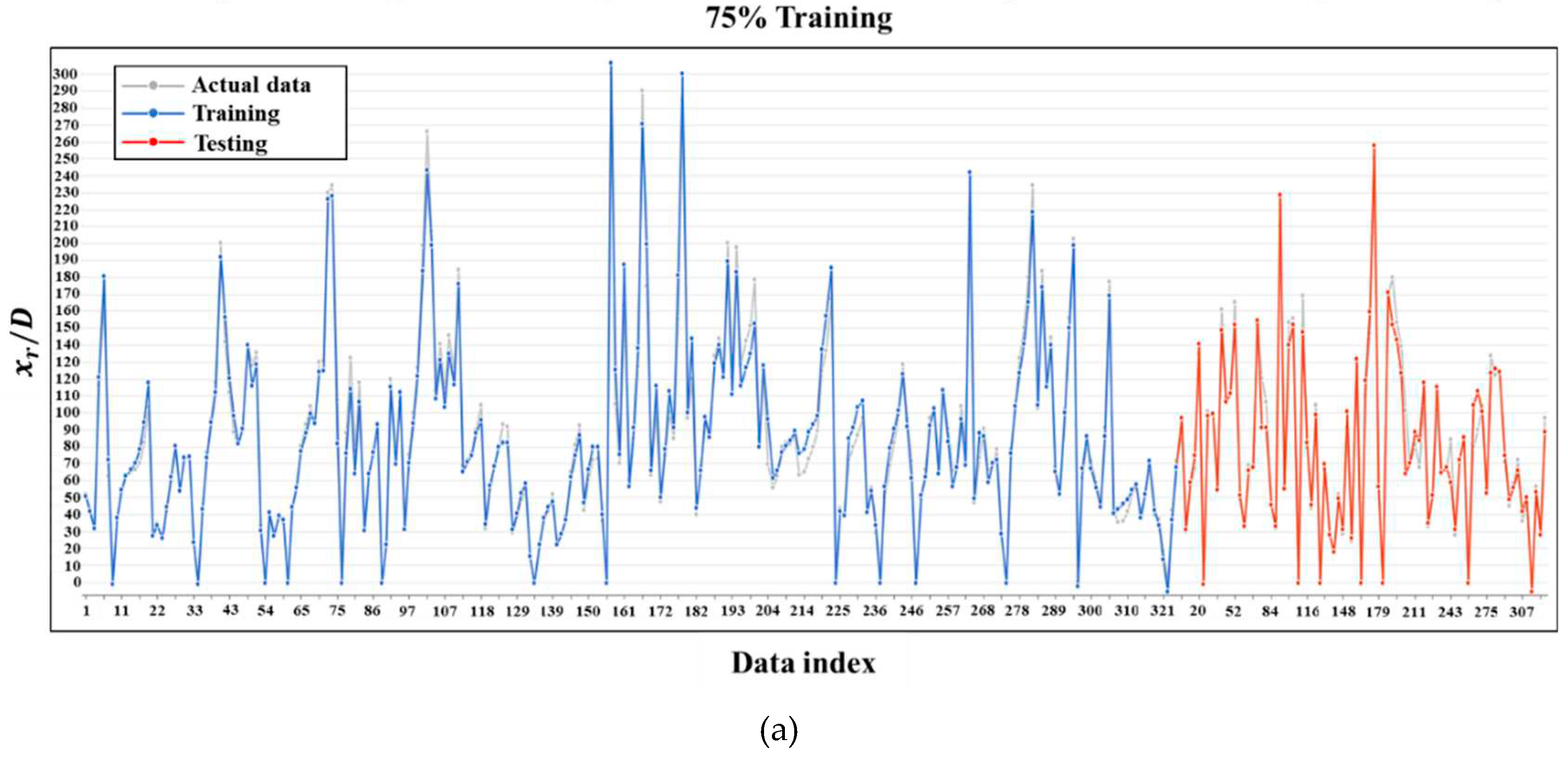
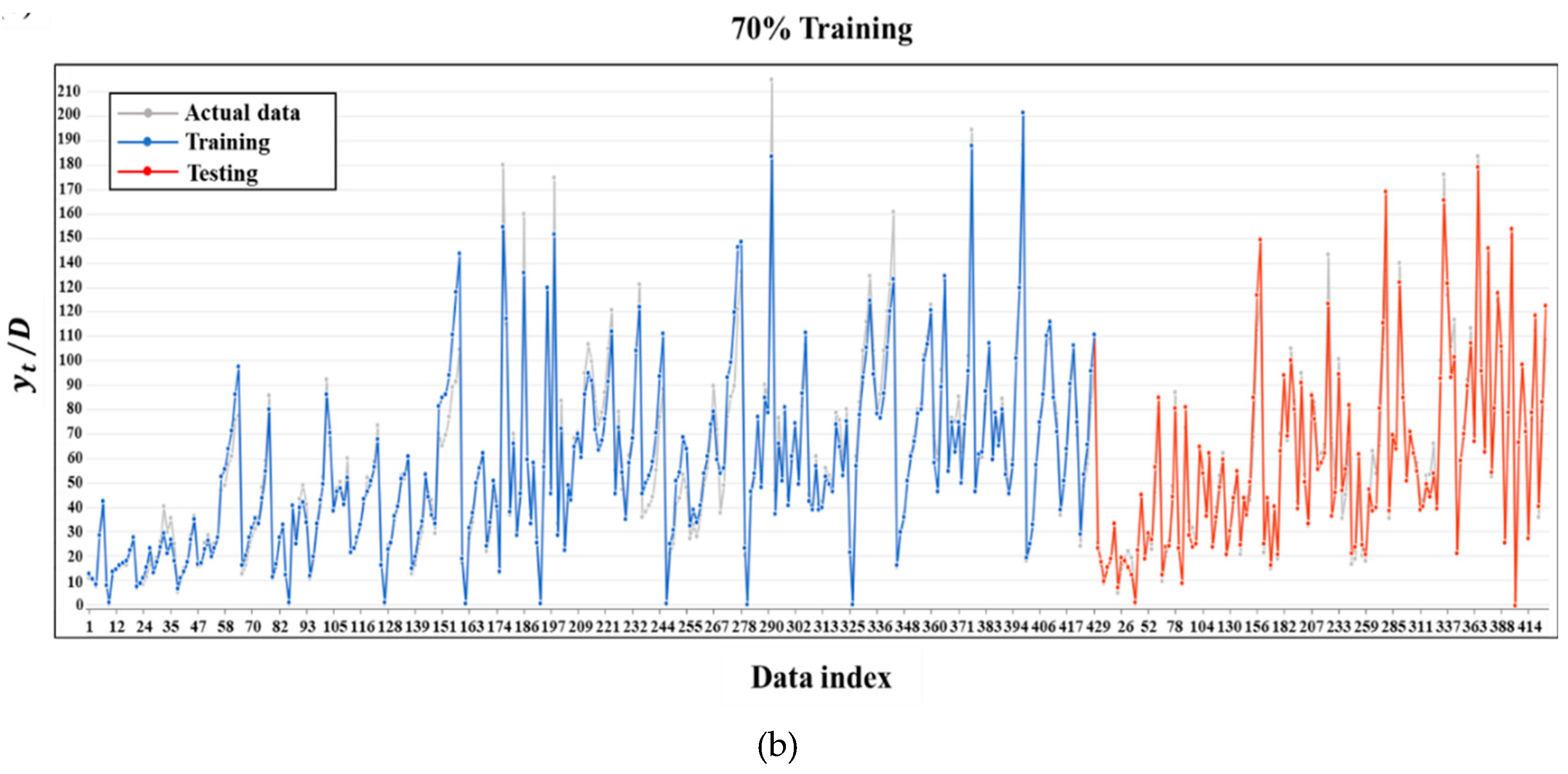
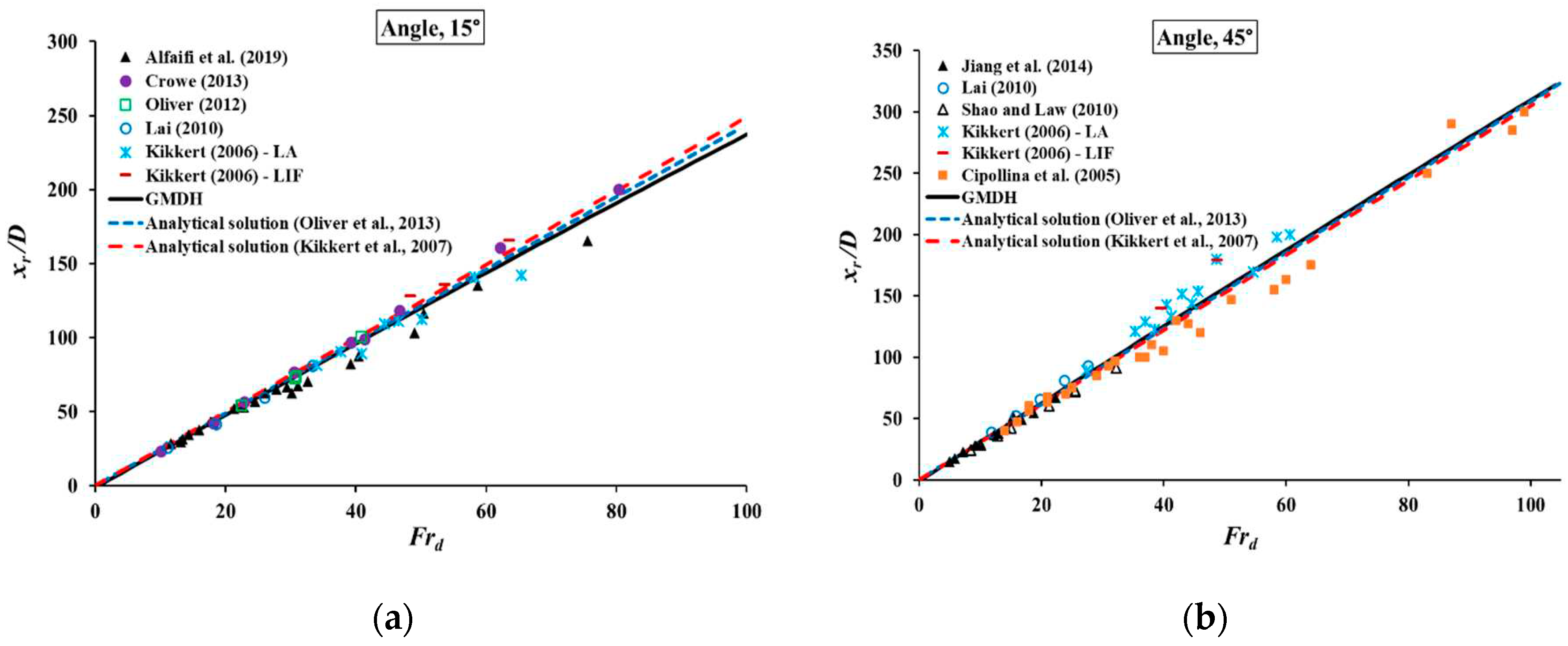
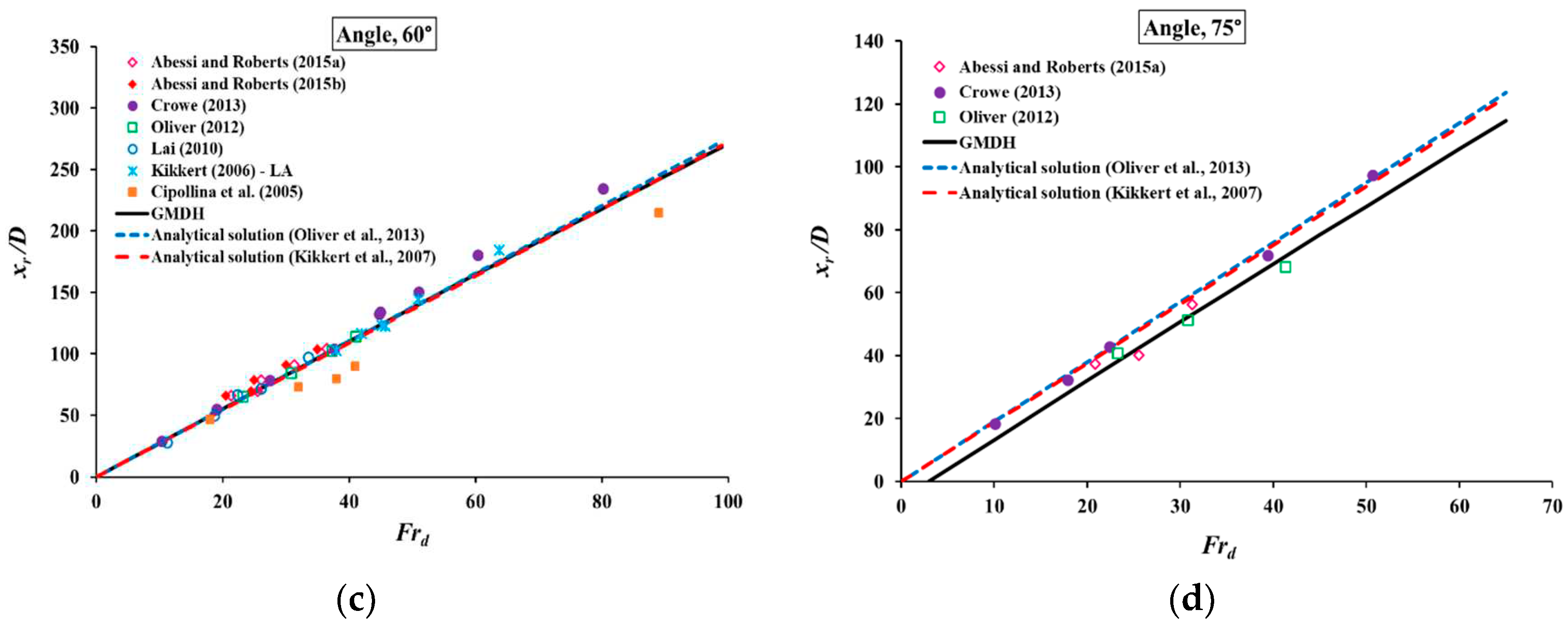
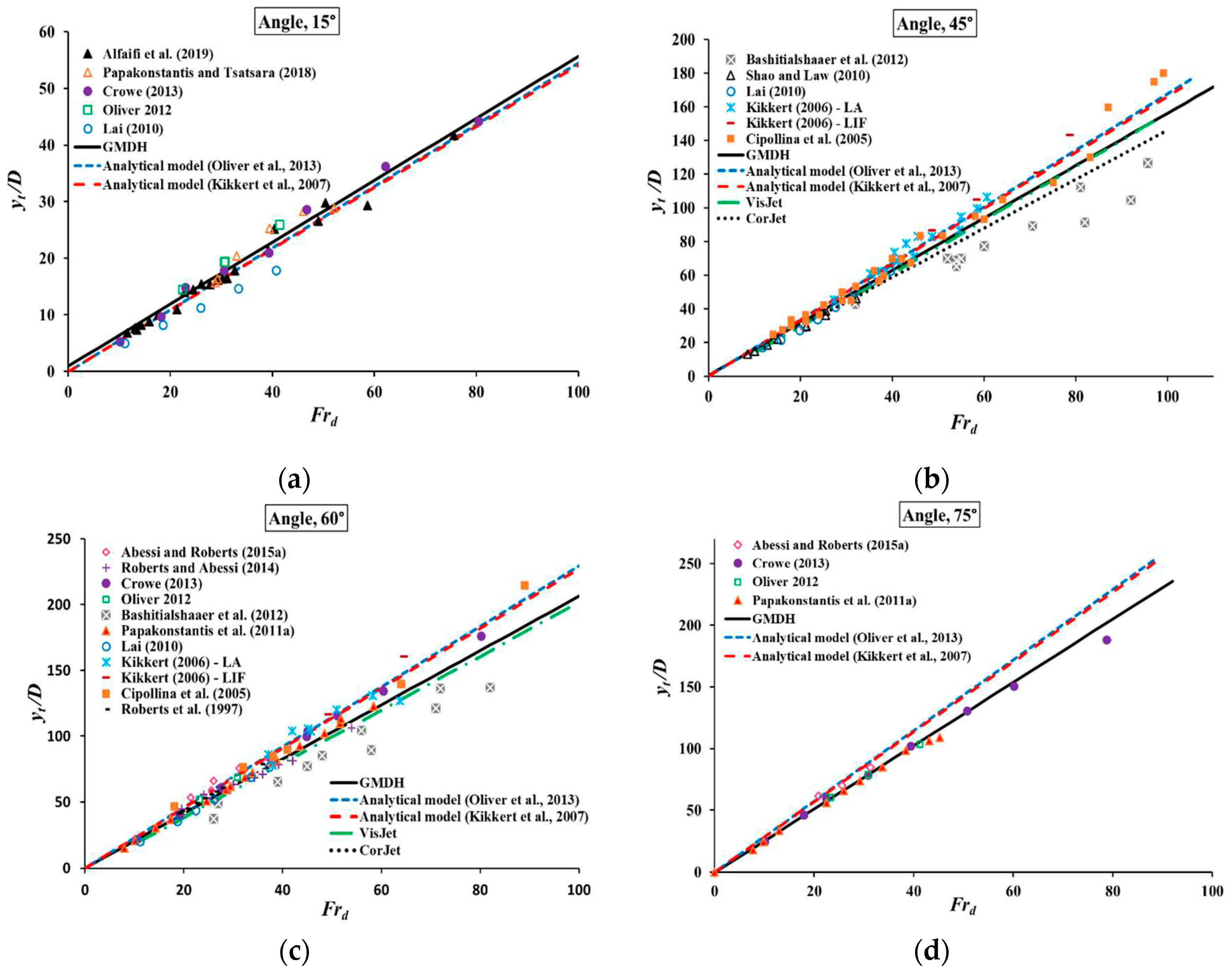
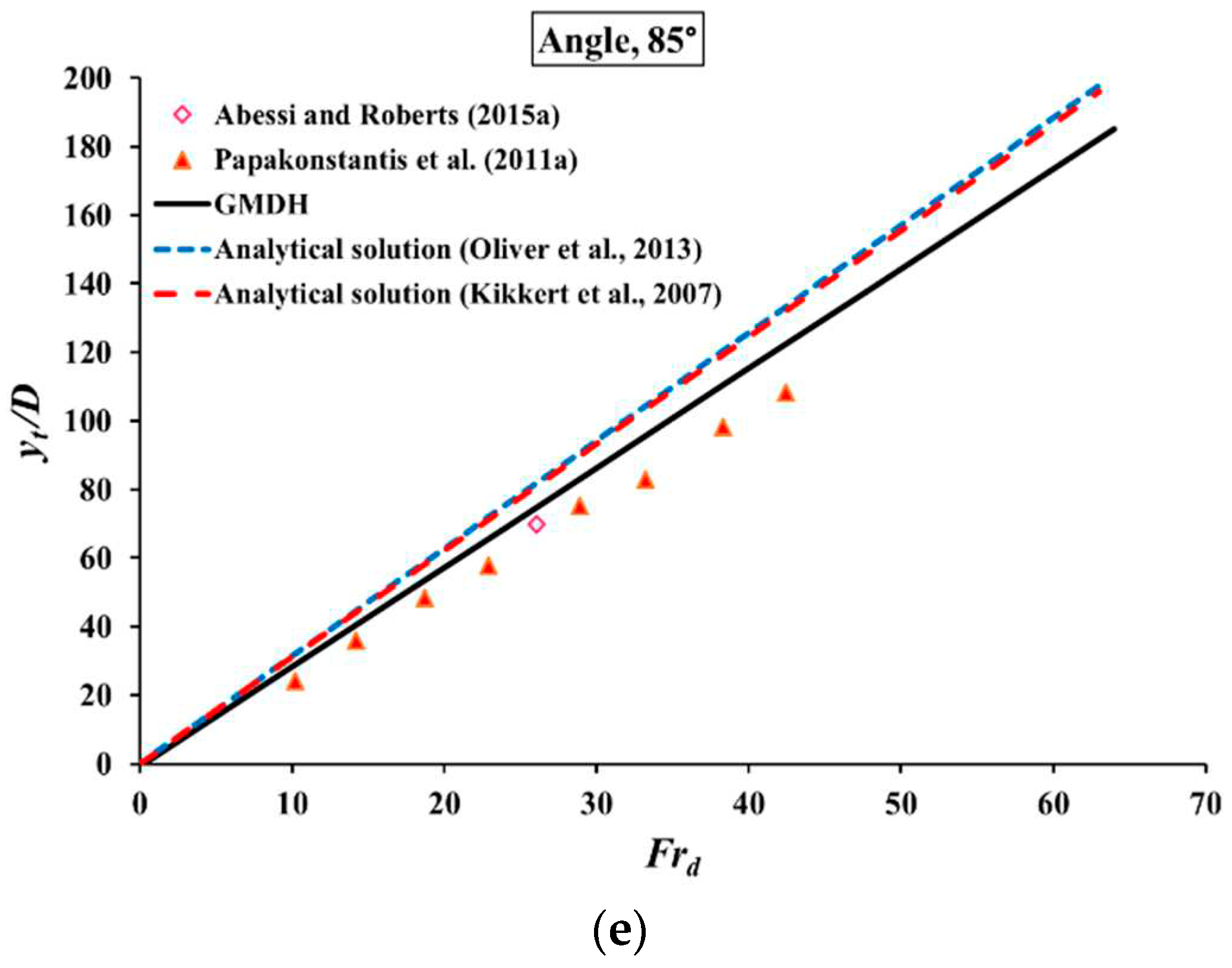
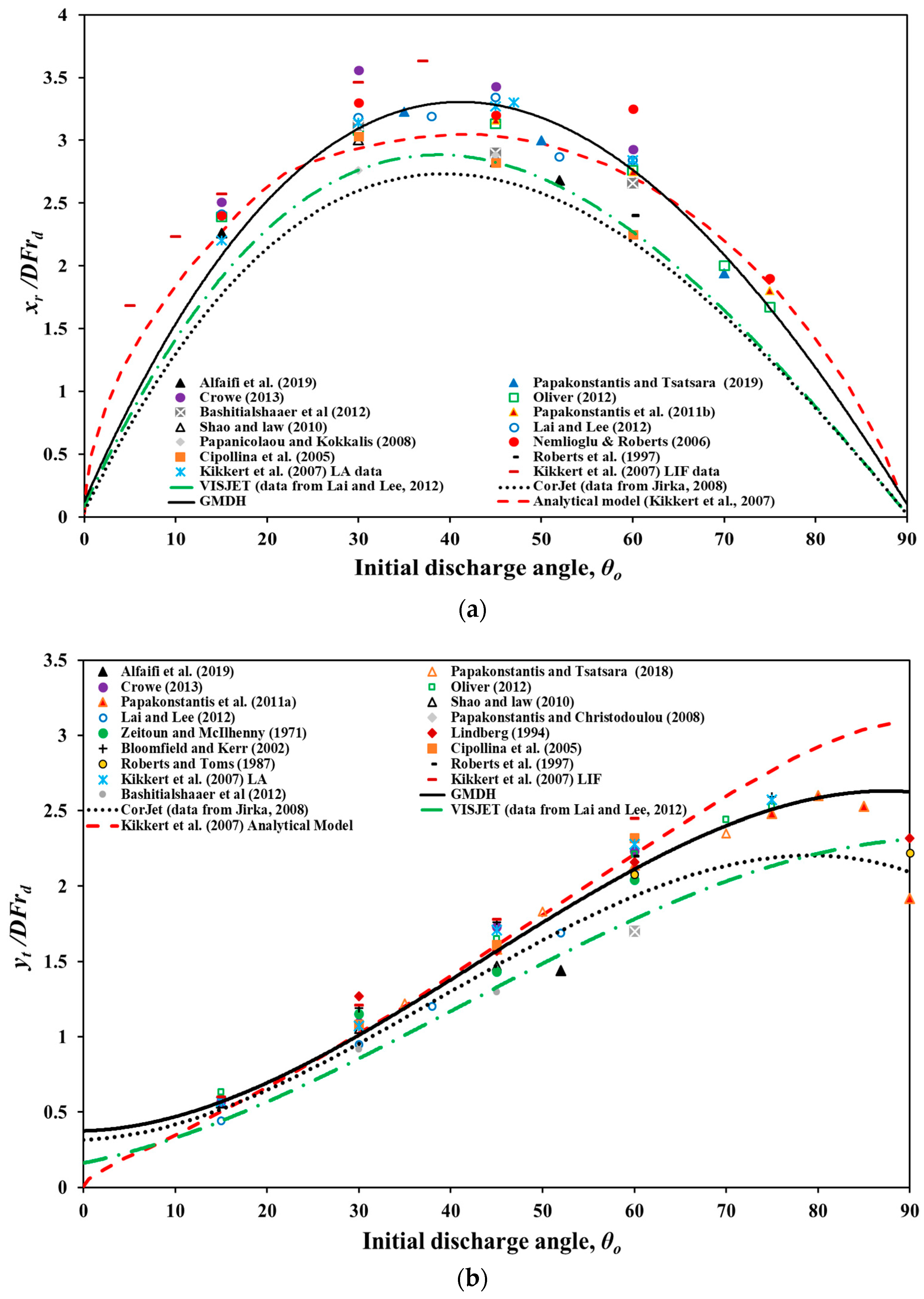
| Geometrical | GMDH proposed equations | |
| (4) | ||
| (5) | ||
| (6) | ||
| (7) |
|
Geometrical parameter |
R2 | MAE | RMSE | R2 | MAE | RMSE |
| training | testing | |||||
| 0.948 | 5.911 | 8.239 | 0.936 | 6.809 | 9.192 | |
| 0.971 | 6.052 | 8.556 | 0.951 | 6.499 | 10.143 | |
| 0.962 | 4.009 | 5.711 | 0.947 | 4.458 | 6.861 | |
| 0.945 | 5.471 | 8.298 | 0.956 | 5.236 | 7.804 | |
|
Geometrical parameter |
Angle |
GMDH model |
CORJET | VISJET |
Kikkert et al. (2007) |
Oliver et al. (2013) |
| 15° | 6.39 | - | - | 7.94 | 6.86 | |
| 45° | 10.82 | - | - | 11.72 | 10.77 | |
| 60° | 9.42 | - | - | 12.29 | 9.51 | |
| 75° | 4.35 | - | - | 20.80 | 4.99 | |
| 15° | 3.35 | - | - | 3.72 | 3.66 | |
| 45° | 11.13 | 12.16 | 11.31 | 15.71 | 12.44 | |
| 60° | 9.81 | 12.17 | 10.96 | 18.72 | 12.31 | |
| 75° | 3.93 | - | - | 12.00 | 12.95 | |
| 85° | 9.06 | - | - | 15.53 | 16.39 |
| GMDH model for the geometrical characteristic |
Number of sample size |
MPE | WUB | 95% PEI | |
| 309 | +0.29 | 8.58 | ±0.96 | -0.66 to +1.25 | |
| 305 | -0.11 | 9.29 | ±1.04 | -1.15 to +0.93 | |
| 341 | -0.10 | 6.11 | ±0.65 | -0.75 to +0.55 | |
| 420 | -0.03 | 8.25 | ±0.79 | -0.82 to +0.76 |
Disclaimer/Publisher’s Note: The statements, opinions and data contained in all publications are solely those of the individual author(s) and contributor(s) and not of MDPI and/or the editor(s). MDPI and/or the editor(s) disclaim responsibility for any injury to people or property resulting from any ideas, methods, instructions or products referred to in the content. |
© 2023 by the authors. Licensee MDPI, Basel, Switzerland. This article is an open access article distributed under the terms and conditions of the Creative Commons Attribution (CC BY) license (http://creativecommons.org/licenses/by/4.0/).





